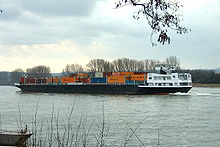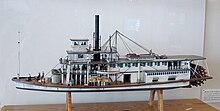

|
m →History: river link fix and screw-propeller link
|
m capitalized letters
|
||
| Line 112: | Line 112: | ||
*[[P.A. Denny (ship)]] |
*[[P.A. Denny (ship)]] |
||
*[[Sternwheeler]] |
*[[Sternwheeler]] |
||
*[[ |
*[[Paddle Steamer]] |
||
==References== |
==References== |
||
This article may need to be rewritten to comply with Wikipedia's quality standards. You can help. The talk page may contain suggestions.
|


Ariverboat is a ship designed for inland navigation. These vessels are usually less sturdy than ships built for the open seas, with limited navigational and rescue equipment, as they do not have to survive the high winds or large waves characteristic on large lakes, seas or oceans. They are limited in size by width and depth of the river as well as the height of bridges spanning the river.
While a ferryboat is often used to cross a river, a riverboat is used to travel along the course of the river, while carrying passengers and cargo, or both, for revenue. (Vessels like 'Riverboat casinos' are not considered here as they are essentially stationary).
The significance of riverboats is dependent on the number of navigable rivers and channels as well as the condition of the road and rail network. Generally speaking, riverboats provide slow but cheap transport especially suited for bulk cargo and containers.
As early as 20,000 BC people started fishing in rivers and lakes using rafts and dugouts. Roman sources dated 50 BC mention extensive transportation of goods and people on the river Rhine. Upstream, boats were usually powered by sailsoroars. In the Middle Ages, towpaths were built along most waterways to use working animals or people to pull riverboats. In the 19th century, steamboats became common.

The most famous early riverboats were on the rivers of the midwestern and central southern United States, on the Mississippi, Ohio and Missouri rivers in the early 19th century. Out west, riverboats were common transportation on the Colorado, Columbia, and Sacramento rivers.
It is these early steam-driven river craft that typically come to mind when "steamboat" is mentioned, as these were powered by burning wood, with iron boilers drafted by a pair of tall smokestacks belching smoke and cinders, and twin double-acting pistons driving a large paddlewheel at the stern churning foam. This type of propulsion was an advantage as a rear paddlewheel operates in an area clear of snags, is easily repaired, and is not likely to suffer damage in a grounding. By burning wood, the boat could consume fuel provided by woodcutters along the shore of the river. These early boats carried a brow (a short bridge) on the bow, so they could head in to an unimproved shore for transfer of cargo and passengers.
Modern riverboats are generally screw (propeller) driven, with pairs of diesel engines of several thousand horsepower.
Many of the riverboats shown below were operating on the Yangtze (Chang Jiang) river.
Some large riverboats are comparable in accommodation, food service, and entertainment to a modern oceanic cruise ship. Tourist boats provide a scenic and relaxing trip through the segment they operate in.
On the Yangtze River, they typically employ staff for double duties: both as serving staff and as evening-costumed dancing entertainers.
 |
Smaller luxury craft (without entertainment) operate on European waterways - both rivers and canals, with some providing bicycle and van side trips to smaller villages.
High speed boats such as those shown here had a special advantage in some operations in the free running Yangze. In several
locations within the three gorges one way travel was enforced through fast narrows. While less maneuverable and deeper
draft vessels were obliged to wait for clearance these high speed boats were free to zip past waiting traffic by running in the shallows.
 |
 |
Smaller riverboats are used in urban and suburban areas for sightseeing and public transport. Sightseeing boats can be found in Amsterdam, Paris, and other touristic cities where historical monuments are located near water.
The concept of local waterborn public transport is known as Water taxi in English-speaking countries , vaporetto in Venice, water/river tramway in former Soviet Union and Poland (although sightseeing boats can be called water tramways too). Local waterborn public transport is similar to ferry.
The transport craft shown below is used for short distance carriage of passengers between villages and small cities along the Yangtze, while Larger craft are used for low cost carriage over longer distance, without the fancy food or shows seen on the tourist riverboats. In some cases the traveller must provide their own food.
 |
 |
Roads through this region are inadequate for heavy truck transport and roads along the river are extremely dangerous. As the major rivers are mostly east-west, most railroad transport is typically north-south.
Here, a drive/on drive/off ramp barge is used to transport trucks. In many cases the trucks transported are new and are being delivered to customers or dealers. Perhaps unique to China, the new trucks observed traveling upstream were all blue, while the new trucks traveling downstream were all white.

Low value goods are transported on rivers and canals worldwide, since slow speed barge traffic offers the lowest possible cost per ton mile and the capital cost per ton carried is also quite low compared to other modes of transport

